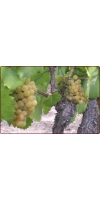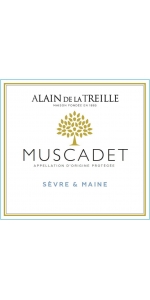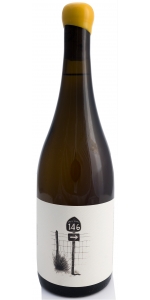Melon de Bourgogne

Melon de Bourgogne is a white grape variety that is grown in the Loire Valley of France. This grape is known in the Muscadet dry white wine, which is made almost entirely out of the Melon de Bourgogne variety. The grape variety is so common in the wine that the variety is often referred to as “Muscadet”. Melon de Bourgogne is also known as Melon, and is also grown in North America. The grape is said to have originated in Burgundy and grown there until the variety was destroyed in the 18th century. In the winter of 1709, many vines in Loire and Nantes were destroyed. Out of the cold winter, Melon was introduced because of its ability to withstand frost. DNA research shows that Melon de Bourgogne is a mix between Gouais blanc and Pinot blanc. In the United States, using the term “Muscadet” for wines created in America is prohibited. The wines can use the term “Melon” or “Melon de Bourgogne”. The grape is grown in Oregon, where it is called by the term “Melon.” This variety is perfect with fresh shellfish, such as oysters, and is great while young. The wine lends citrus and salty notes and has a nice silky texture.
Alain de la Treille Muscadet Sevre et Maine is made from 100 percent 100% Melon de Bourgogne
This great dry white wine offers a unique style with a fine and delicate minerality... Beautiful tension on the palate followed by hints of flower, melon and lime, that finishes with a refreshing crispness.
MAISON ALAIN DE LA TREILLE is located in the heart of Loire Valley since 1885. Vineyards owner and winemaker, ALAIN DE LA TREILLE creates diverse and delicate wines on the most prestigious vineyards: Muscadet, Touraine, Vouvray, Sancerre...
Average age of the vines is 20 years old.
We produce a part of this cuvee with 12 hours skin maceration and another part from directly pressed grapes
Wine was slightly filtered before bottling to ensure wine will remain stable.
Ideal with all fishes, seafood and for sure oysters but do not hesitate to match it as well with a great goat cheese.
This great dry white wine offers a unique style with a fine and delicate minerality... Beautiful tension on the palate followed by hints of flower, melon and lime, that finishes with a refreshing crispness.
MAISON ALAIN DE LA TREILLE is located in the heart of Loire Valley since 1885. Vineyards owner and winemaker, ALAIN DE LA TREILLE creates diverse and delicate wines on the most prestigious vineyards: Muscadet, Touraine, Vouvray, Sancerre...
Average age of the vines is 20 years old.
We produce a part of this cuvee with 12 hours skin maceration and another part from directly pressed grapes
Wine was slightly filtered before bottling to ensure wine will remain stable.
Ideal with all fishes, seafood and for sure oysters but do not hesitate to match it as well with a great goat cheese.
The Muscadet-Sèvre et Maine sub-appellation produces 80% of all Muscadet wine. Covering 8,200 hectares with 23 villages, the appellation is named after the rivers Sèvre and Maine that flow through it. Soil types ranges from granite and schist hillsides around the village of Saint-Fiacre-sur-Maine, to the predominantly clay based soils of Vallet. Almost half of the wine is aged sur lie.
I Brand Melon de Bourgogne Chalone is made from Melon de Bourgogne.
The Graff Family began working in Chalone in the early 60s, with Dick Graff as the driving force behind the Chalone Vineyard, building, with the support of his brothers and a gaggle of stockholders, the original 1919 planting to international fame. After selling the Chalone group and Dick’s untimely death in a plane crash, the family’s land holdings have shrunk progressively to just this 160 acre parcel, owned by Dave Graff and his children. On those 160 acres is a small 3 acre vineyard planted in 1989 to Syrah, Mourvédre and Melon de Bourgogne. The site has depleted, granitic soils. The Melon de Bourgogne in Chalone was originally thought to be Pinot Blanc. Dick Graff distributed cuttings of these vines as far as Oregon. In the 1970s, a visiting ampelographer correctly identified the vines as Melon de Bourgogne. These vines were selected from the older ‘Pinot Blanc’ planting and can legally be labeled as either (but we like accuracy).
The wine comes from a tiny parcel of 30+ year old Melon planted on depleted granitic soils. The warm days and cold nights of the Chalone AVA produce a perfect balance of concentration and acidity, which Ian Brand amplifies with a few days of skin contact. The pure aromas of light peach, pear and gardenia are slightly toasty on the nose. The palate is defined by lemon-skin and grapefruit-pith grip, with a touch of baked apple in the midpalate.
- back
Selected Options
Grape Types
Categories
Pricing
Countries
Regions
Grape Types
Wineries
Organic/Free Shipping
Pulled from a Gentleman's cellar, all wines from this cellar have been purchased by the owner either from the importer or direct from winery. They stayed in his cellar until being moved to the Timeless Wines warehouse.
Chakana Singular Torrontes de Maceracion Prolongada is 100% Torrontes.
Deep, orange color.
Complex nose, notes of white flowers, peaches, evolution and skins aromas. Nice texture, good structure, final minerality, perfectly balanced by good freshness.
Chakana is the name of the Southern Cross constellation. Its rotation in the sky throughout the year made it an effective agricultural calendar for the ancient Andean people.






